Q&A – Ask Neil: November 9, 2023
(Please read these instructions carefully.)
Before you post your question, please look at recent issues to see if someone else has already asked it. You might find your answer there.
How to submit your question…
(Note: You may need to allow a pop-up window to come up in order to get the link for sending your photo(s). If you have already submitted your question and didn’t see the pop-up window, please click here.)
• Click the link provided below to post your question. After you submit your question, a new window will pop up giving you the address to which you can e-mail a SHARP, HIGH-RESOLUTION PHOTO to accompany your question. Please DO NOT SEND THUMBNAIL PHOTOS in case I need to zoom in to see things.
• Click here to post your question.
• Please ONLY POST YOUR QUESTION ONE TIME. We can only accept a set number of questions each week, and when we get duplicates it costs other people their chances.
• One question per reader, please.
• Please use this only for posting questions – not for standard emails.
• Watch for your answer in the following week’s e-gardens.
• I choose those of greatest general interest. For example, plant IDs seldom make the cut.
• I must have your first name or initials.
• I must have your city or county. (Texas is a very large state.)
QUESTION 1
WHAT SHOULD I DO WITH MY NEW SHUMARD RED OAK?
Question: We planted this Shumard red oak last March. We wrapped it and kept it watered all summer. I noticed the wrap was turning gray, so I wanted to replace it. I found this wound beneath the wrap. What should I do now? Diane D., Houston.
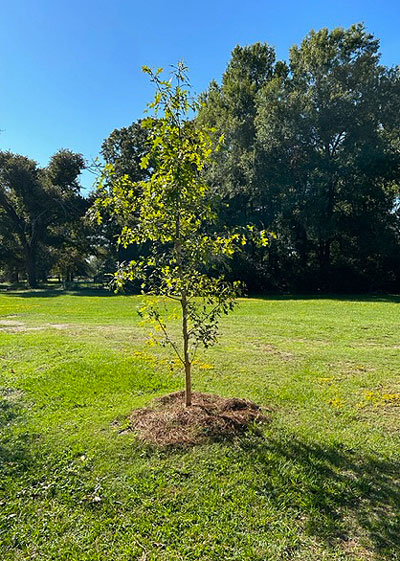
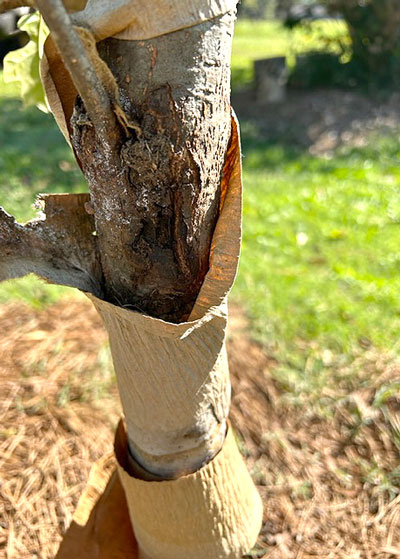
Answer: You did everything perfectly. It looks like there were several small branches clustered together that were removed at the same time. That seems to be where the decay began. It may extend down beneath the lower wrap. Hopefully it is dry and not oozing. As for what you might do now, in looking at the photo of the entire tree, if it were mine, I would remove the rest of the wrap for the time being.
I would prune the remaining branch out of that cluster. Viewed from farther back, it appears that there are three small branches down toward the bottom that should probably come off now, one going off to the left in your photo and two to the right. While you would want to leave 1/4-inch of branch collar for the other two, this one adjacent to the decay probably should be cut flush to the trunk so that the tree can heal across all wounds simultaneously.
Because it would slow the healing process, I would not apply pruning sealant. Granted it’s a rule that all cuts of this size and larger should be sealed to prevent entry of oak wilt fungus, there is only a tiny chance of that happening, while there is a much greater chance of decay proceeding behind the sealant.
As to whether I would wrap it again, I would wait until early spring to make that decision. I probably would do so to protect the trunk from sunscald for the next couple of years, but I’d continue to pull the wrap back every couple of months to inspect this decay and check on the healing progress. Hopefully you’ll see new bark forming across the wound.
QUESTION 2
HOW DO I START COMPOSTING, AND HOW DO I USE IT?
Question: How do I get started composting, and how can I best put the compost to use when it’s finished? Olga G-O, Dallas.
Answer: Composting consists of recycling organic matter from your landscape and garden (and a bit from your house) and processing it until it is no longer recognizable. The list is long, including grass clippings, tree leaves, stubble from flower and vegetable gardens, any manure you can collect from stables or barnyards, kitchen vegetable waste, etc. The finer you shred it the more quickly it will be decay and be ready for use. Generally, that’s going to take a minimum of 8 to 12 months, although there are many enthusiasts who claim their processes can give you compost that’s ready for use in just a couple of months.
I prefer to use a blend of many types of organic matter. I put it into a pile (either within a formal bin or in an open pit), and I layer it an inch or two at a time. I’ll put an inch of shredded tree leaves, then grass clippings, manure, old compost (to introduce microbes into the pile) and even finely ground wood chips. I garden in a pecan forest, so our compost pile is heavily influenced by pecan leaves and husks. I’ll also include one cup of all-nitrogen fertilizer per cubic yard of compost prior to turning the pile.
Keep the pile moist and warm by covering it with black polyethyene plastic film. Use a spading fork to turn the pile every couple of months and you’ll see the process moving forward.
Use your compost to improve any soil. Use the compost to help sandy soils retain moisture and nutrition, and use compost to help break up clay soils.
QUESTION 3
WHAT SHOULD I DO WITH MY MATURE ENCORE AZALEA BED?
Question: I have a raised bed of Encore azaleas that’s about 20 years old. They have grown to about 6-7 ft. tall and they bloom fairly well (Nov. 3 photo). They have lost a lot of branches in their middles after the past winters. Should I cut them back by half? The sparsest spots on the right in my photo are on the north side of the bed. Jay A., Colleyville, Tarrant County.
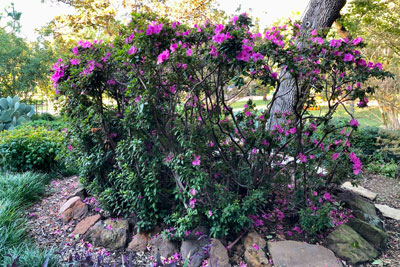
Answer: (Nice landscape!) Yes, essentially so, I would prune them. It’s funny you would ask that, because I always open all the photos and crop them, etc., before I post and then I answer the questions associated with them. If you hadn’t asked about pruning, I was going to suggest it. Trim them with lopping shears in late January, one branch at a time. Tailor and reshape them. That’s going to mean that you’ll give up a good bit of the spring bloom, but you’ll benefit from the flush of new spring growth.
Apply a high-nitrogen fertilizer to stimulate that new leaf and twig growth, and water them thoroughly. You probably will need to topdress them with 2-3 inches of organic matter. I prefer a 50-50 mix of finely ground pine bark mulch blended with sphagnum peat moss. Your original planting bed mix has broken down over time, and this will give it a booster shot. For those of us in Blackland Prairie soils we generally have to carry that one step farther by completely removing the old plants, redoing the beds entirely and either replanting the trimmed shrubs or, better by far, planting new, vigorous plants for a fresh start.
QUESTION 4
HOW CAN I BE SURE I HAVE THE BEST POTTING SOIL?
Question: I need a lesson in potting mixes. Most of my gardening is now in pots, but I am not pleased with what the “big box” stores have to offer. The mixes don’t seem to hold water sufficiently or it doesn’t soak in evenly. How can I best amend it to have a healthy mix? Claudia S., Corpus Christi.
Answer: I want my potting soil to be light in weight and highly organic. When I pick up a bag of it, I want to be surprised by its light weight. I mix my own. My formula will vary a little bit depending on the plants that I’m potting, but I’ll start with 50 percent sphagnum peat moss, 25 percent finely ground pine bark mulch, 15 percent horticultural perlite, and then, just to give my potting soil some ballast so the pots don’t all blow over, 10 percent expanded shale. If I’m growing ferns I may increase the sphagnum peat and decrease the perlite and shale by just a bit each. If I’m growing cacti, I will certainly decrease the peat and increase the expanded shale.
QUESTION 5
WITH A BUBBLER ON MY HOSE, HOW LONG WILL IT TAKE TO DISPERSE 30 GALLONS OF WATER?
Question: Thanks for your help in watering new trees. With a water bubbler on my hose, how long will it take to disperse 30 gallons of water? Claudia V.M., McKinney.
Answer: There is no answer for that because it depends on your hose diameter and water pressure and, of course, how far open you turn the faucet. But you can get a pretty good idea for yourself if you use a 5-gallon bucket and see how long it takes to fill it. Multiply that times 6 and you’ll have your answer.
QUESTION 6
WHAT IS THE BEST WAY TO FILL SUNKEN SPOTS WHERE 12 LARGE TREES WERE REMOVED 11 YEARS AGO?
Question: We had 12 large pine trees removed from our yard in 2012. A stump grinder removed the stump and upper roots below grade, but now the roots are decaying. It’s leaving low spots in our yard. What is the best way to fill those low spots in the turf? Darwyn C., Marshall.
Answer: If there is organic matter, namely roots, that are still decaying in the soil, the area will continue to sink until it has all run its course. Anything you can do to remove the remains of the roots will be to your advantage. When you feel most of it has decayed, fill the holes with the same type of soil you have in the rest of your yard. Layer it in an inch or two at a time, and pack each layer as you do, then add the next layer. Practically speaking, you’ll probably want to finish it out with a 1-inch mounded layer over the top to allow for any final settling that is bound to occur. Should you have even more and end up with a shallow furrow a year or two from now, you can fill low depressions of less than 1 inch with washed brick sand. Grass will grow across the top of it.
QUESTION 7
WHAT SHOULD I DO ABOUT THIS LARGE ROCK THAT’S NOW EMBEDDED IN THE TRUNK OF MY LIVE OAK?
Question: We have a large live oak with a rock lodged into the trunk and ground. I have tried to remove it, but without avail. As the tree grows more into the rock do you think it will damage the tree in any way? Craig E., Willow Park, Parker County.
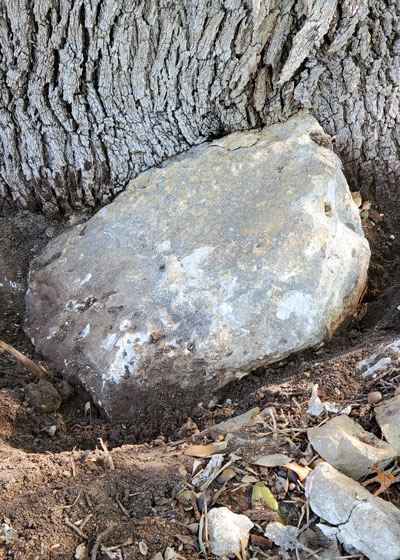
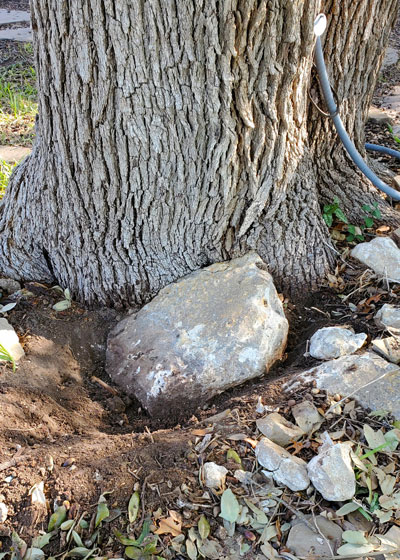
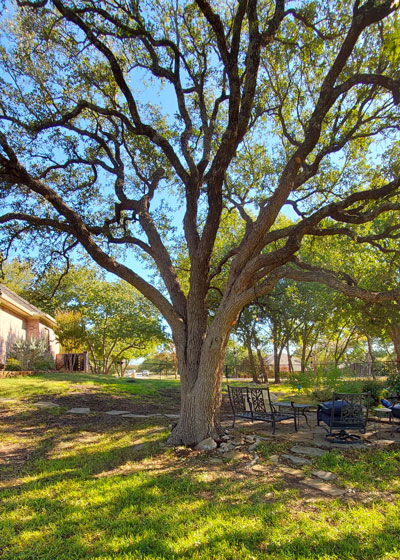
Answer: You need to take corrective action as soon as you can to remove the rock, or as much of it as you can, as soon as you can. The tree’s trunk would be quite satisfied to grow around it, but the rock would do nothing good for the longevity of the tree. I can’t tell from your photos how much of the rock extends below the soil line. Try excavating beneath it to do a little discovery work. If you opened up a fairly large hole beside the trunk, you might find that with a little prying you could get the rock to pop loose.
Another alternative would be to use a star chisel to break into the rock. Wear goggles and protective gloves and try chipping away at an edge to see if you can break it into fragments.
If in doubt, hire a certified arborist to do some or all of this work for you.
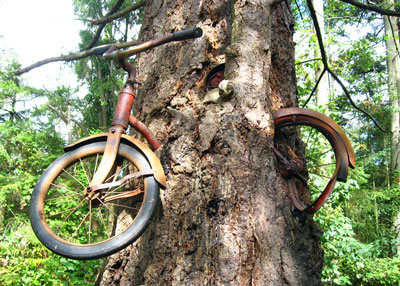
Note: Trees can lead long, healthy lives in spite of tangible things existing within them. I offer this well-documented proof. It’s a bicycle, lost in the 1950s and not re-discovered until 2012. It’s in Vashon Island, Washington.
Here’s the entire story if you care to read it.
